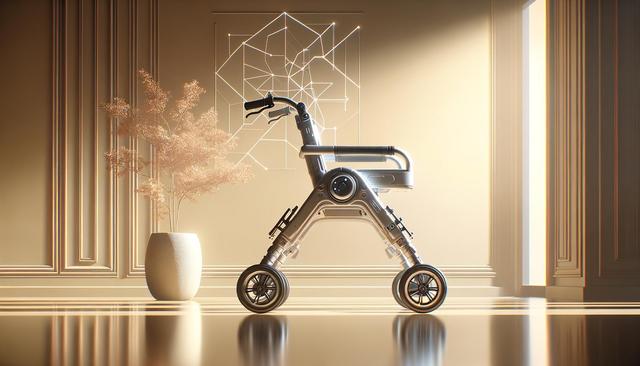
Forget Traditional Walkers – This New Design Has Everyone Talking
Reimagining Mobility: A Shift from Traditional Walkers
For decades, walkers have remained largely unchanged in design, often bulky, difficult to maneuver, and limited in function. However, recent innovations are reshaping what mobility assistance can look like. These new walker designs incorporate user-focused features, placing an emphasis on comfort, safety, and independence. Unlike their predecessors, modern walkers blend function with form, offering seniors a more adaptable and stylish mobility solution. This evolution is especially significant for those seeking the Best Rollators for Seniors, as newer options provide enhanced versatility and ease of use.
Traditional walkers typically require lifting with every step or offer limited support on uneven terrain. In contrast, updated rollators are built with lightweight frames, ergonomic hand grips, and advanced wheel systems that glide smoothly both indoors and outdoors. Some even include shock absorbers to reduce joint strain and increase overall comfort when in motion. These improvements not only support physical well-being but also promote a more active lifestyle for older adults.
Design Innovations That Make a Difference
The new wave of walker design introduces features that prioritize user experience. These aren’t just minor tweaks; they represent a comprehensive rethinking of how seniors interact with mobility aids. These enhancements include:
- Foldable frames for easy storage and transport
- Height-adjustable handles for personalized support
- All-terrain wheels that improve stability on multiple surfaces
- Built-in seating and backrests for convenient resting
- Secure braking systems for greater control
For those comparing options within the Best Rollators for Seniors category, such features elevate the standard. Moreover, many of these new models are designed to reduce the stigma that can sometimes accompany mobility devices. With sleek, minimalist aesthetics, they appear more like accessories than medical equipment, helping users feel more confident in public settings.
Functionality Meets Lifestyle
One of the most significant shifts in walker design is the integration of lifestyle features. Many newer rollators now come with:
- Built-in storage compartments or bags
- USB charging ports for mobile devices
- LED lighting for visibility in low-light conditions
These additions may seem small, but they cater directly to the needs of modern seniors who value convenience and autonomy. When evaluating the Best Rollators for Seniors, these lifestyle features often tip the scale in favor of newer designs. They support a more seamless daily routine, whether it’s a walk in the park, a trip to the grocery store, or navigating a crowded event.
Increased compatibility with accessories is another benefit. From cup holders to cane attachments, these rollators can be customized to suit varying needs, making them a more practical and appealing choice for a wide range of users.
Safety and Comfort Lead the Way
While design and lifestyle enhancements are important, safety remains a central focus. New walker models are built with improved weight distribution, anti-tip features, and intuitive brake systems. These developments help minimize accident risk, particularly for users with balance or coordination challenges.
Comfort is equally prioritized. Padded seats, adjustable backrests, and handle grips made from soft, non-slip materials ensure users can rely on their device for longer periods without discomfort. These features are crucial when considering the Best Rollators for Seniors, as they directly impact the user’s willingness to incorporate the walker into their daily life.
Additionally, some rollators now include smart technology integrations. These can track the user’s walking patterns, monitor posture, or even send alerts in case of a fall. Though still emerging, such technologies represent a promising direction for mobility aid development, supporting both independence and peace of mind for users and caregivers alike.
Choosing the Right Model for Your Needs
With so many new options available, selecting the right walker can be overwhelming. It’s essential to focus on personal needs and preferences. Questions to consider include:
- Will the walker be used indoors, outdoors, or both?
- Is storage space a concern?
- Does the user need a seat for resting during walks?
- Are there any specific medical conditions that require additional support?
By taking the time to assess these factors, users can identify models that align with their lifestyle and health requirements. Among the Best Rollators for Seniors, models differ in weight capacity, wheel size, seat comfort, and portability, so it’s worth exploring various designs before making a decision. Consulting with a healthcare provider or mobility specialist can also provide valuable guidance.
Ultimately, the goal is to find a walker that empowers the user, offering not just support, but also freedom of movement and a renewed sense of confidence.
Conclusion: Empowering Mobility Through Innovation
The evolution from traditional walkers to modern, user-focused rollators marks a meaningful advancement in mobility aids. These new designs not only improve physical support but also enhance everyday living through thoughtful features and aesthetic appeal. For seniors seeking greater independence and comfort, exploring the latest options among the Best Rollators for Seniors can lead to a more active and fulfilling lifestyle. As innovation continues, the future of senior mobility looks more promising than ever—blending safety, style, and functionality in ways that meet the real needs of users today.